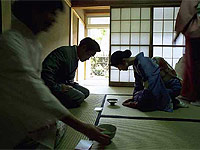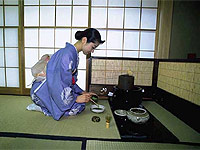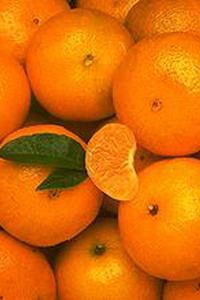nastya
Tea ceremony (part 2)
 TEA ORGANIZATION
TEA ORGANIZATION
Don’t speak words
Guest, host
White Chrysanthemum.
Tea ceremony The tea ceremony is surrounded by a special atmosphere, which the Japanese call “Wa”. In everything, from the garden and the tea house built in it to the decoration of the tea room, everything was created in order to give rise to a certain state of mind.An outdoor garden with mossy stones and an overgrown pond represents a nature that is free from human intervention, and a tea house with props made of uncouth wood or bamboo and a low thatched roof is a natural extension of it. In the tea room, twilight reigns, time here seems to have stopped. All items intended for the tea ceremony have a strictly defined shape, color and texture. Continue reading
Tea ceremony (part 1)
 Among the unique arts, which in our understanding are inextricably linked with Japan, is the art of the tea ceremony, which means literally “tea with hot water” (cha – tea, yu – hot water). The Japanese tea ceremony is not just a tradition, it is a sacrament that cannot but attract attention and arouse respect.
Among the unique arts, which in our understanding are inextricably linked with Japan, is the art of the tea ceremony, which means literally “tea with hot water” (cha – tea, yu – hot water). The Japanese tea ceremony is not just a tradition, it is a sacrament that cannot but attract attention and arouse respect.
The art of the tea ceremony has been studied for years in special schools. Despite the fact that the process itself may seem simple and natural, there is no limit to perfection in this. The Japanese girl’s ability to meet guests, place them on mats according to the Japanese tradition, make fragrant tea, and then pour them into cups with a bow to serve it is the highest sign of aesthetic education. Continue reading
What to see in Japan (part 2)
 The capital of Tokyo is the most visited tourist city in Japan. You should definitely see the Imperial Palace (former Edo Castle), Tosegu Temple, Tokyo TV tower (height 333 meters), Sunshine City skyscraper, ancient parks – Rikushen, Khibiya with regular exhibitions of chrysanthemums, Shiba Park, famous for its pagodas and temples.
The capital of Tokyo is the most visited tourist city in Japan. You should definitely see the Imperial Palace (former Edo Castle), Tosegu Temple, Tokyo TV tower (height 333 meters), Sunshine City skyscraper, ancient parks – Rikushen, Khibiya with regular exhibitions of chrysanthemums, Shiba Park, famous for its pagodas and temples.
There are more than 30 museums in the city, the most interesting of them are the National Museum of Science in Ueno Park, the Shitamashi Historical Museum, the Tokyo National Museum, the National Museum of Modern Art, the Paper Kite Museum, Tokyo Metropolitan Museum of Art, and the Idemitsu Museum with a collection of paintings and calligraphy. Continue reading



